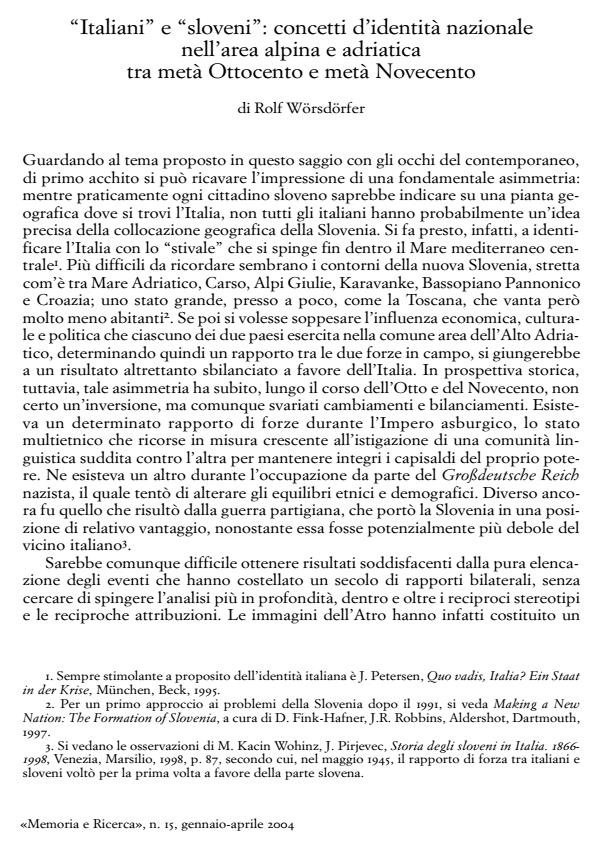Italiani e sloveni: concetti d'identità nazionale nell'area alpina e adriatica tra metà ottocento e metà novecento
Titolo Rivista MEMORIA E RICERCA
Autori/Curatori Rolf Worsdorfer
Anno di pubblicazione 2004 Fascicolo 2004/15
Lingua Italiano Numero pagine 30 P. Dimensione file 144 KB
DOI
Il DOI è il codice a barre della proprietà intellettuale: per saperne di più
clicca qui
Qui sotto puoi vedere in anteprima la prima pagina di questo articolo.
Se questo articolo ti interessa, lo puoi acquistare (e scaricare in formato pdf) seguendo le facili indicazioni per acquistare il download credit. Acquista Download Credits per scaricare questo Articolo in formato PDF

FrancoAngeli è membro della Publishers International Linking Association, Inc (PILA)associazione indipendente e non profit per facilitare (attraverso i servizi tecnologici implementati da CrossRef.org) l’accesso degli studiosi ai contenuti digitali nelle pubblicazioni professionali e scientifiche
Since the late nineteenth century the regions along the north-eastern Adriatic Sea, characterized by a complex pattern of Italian, Slovene, Croatian and other ethnic groups, have been a major battleground of opposing national movements. During the last decades of the Dual Monarchy the German speaking element no longer presented any particular danger to smaller groups of people in the region. Angelo Vivante wrote in 1912 that the only real ethnic conflict was the one between Italians and Slaves. Relations between Italians and Slovenes were characterized by collaborations well as by rivalry and confrontation, depending on which region and which period one may examine. Although it might be difficult to know the real weight of literary imagines and national stereotypes, one may find them in a lot of occasions along the clash between Italians and Slovenes in the 19th and 20th centuries. When in 1920 in the Treaty of Rapallo the former Austrian Küstenland was accorded to Italy; structural multilingualism and spontaneous assimilation processes were in contrast to various programs of ethnic cleansing or bonifica etnica. At first, it was the fascist movement in particular which proceeded with terror directed against Slovenian organisations, parties, clubs and newspapers. The systematic denationalisation campaign of the fascist regime began in various social areas with a certain delay. The political programmes of Italian and Slovene partizan-movements provided new national identities for inhabitants of the border region who had not assumed any particular national attitude or who had suffered by fascist denationalization campaigns accepting the italianità as their only national orientation. In the period after the second World War, subsequent to the assignation of Istria, Fiume and Zara to Yugoslavia, some hundred thousand Italians abandoned their homes and left. The abandoning of the Adriatic region by one of its principal ethnic-national components must be placed in the context of a fierce clash between opposed nationalisms, of rivalry between nation-states, and of the growing importance of national-totalitarian ideologies at the level of the individual state, upon which were superimposed the new divisions of the Cold War. Although in most cases the Italian’s decision to abandon their homelands was not a direct consequence of measures of expulsion, the decision to leave must be seen as the result of specific pressures which make it possible to describe this event as an example of mass expulsion.
Rolf Worsdorfer, Italiani e sloveni: concetti d'identità nazionale nell'area alpina e adriatica tra metà ottocento e metà novecento in "MEMORIA E RICERCA " 15/2004, pp , DOI: